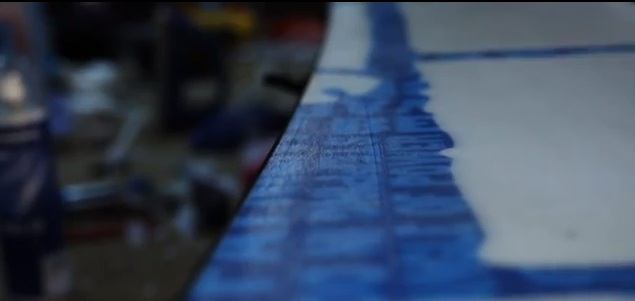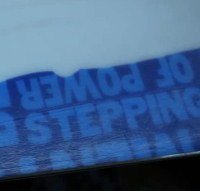
The snowboard base, a simple guide: Extruded vs Sintered explained and does it matter
When looking at the snowboard base why do you need to know the differences of the two main types available on the market today?
A little knowledge about the pros and cons of each of the 2 main types can narrow the options you look at making your search for a new board that much simpler. Ultimately you are more likely to get a board that is better suited to you, your riding style and your experience.
"A little knowledge about the snowboard base can help you narrow your options making the search for a new board a lot easier"
Imagine how dissapointed you would be if you had just spent your hard earned cash on a new board and when you get it home you realised you had gone and got one with the wrong type of base.
As a more experienced rider you suddenly realise that the base is going to be too slow for you or that as a beginner you are have bought a board that you are going to have to spend more on repairing when you pick up the inevitable dings and knocks that we all do when we are learning to ride.
What are the two main types of snowboard base?
The two main types of snowboard base that can be found today are the Extruded and the Sintered base. The difference comes in the way they are made. Each has pro's and con's depending on your experience, riding style and budget.
Below you will find an outline of each helping you decide which would be best for you.
The Extruded base
As a rule of thumb the extruded base will be found on more beginner and entry level snowboards. It is a cheaper base to make and is cheaer to repair than a sintered base. The extruded base is the low maintenance base that will be best for a more inexperienced rider who is more likely to pick up knocks and gashes on the bottom of their board.

If you ride a lot of rails or do a lot of street style riding where your board may get damaged then an extruded base may also be best suited for you. It will keep the costs down when you take it to the shop to have it repaired or make it easier if you want to repair the base yourself.
How is the Extruded base made?
To make an extruded base for a snowboard polyethylene pellets are melted together at an extremely high temperature. Once the pellets have been melted they are then forced together by a special machine that also determines the thickness of the base. The result is a completely smooth piece of material. The base does not have any gaps between the old pellets and is therefore completely non-porous. This means that it is a lot harder to get wax to penetrate the base and will mean an extruded base may be that bit slower than a sintered base.
What are the benefits of an Extruded snowboard base?
- Cheaper to make
- Cheaper to repair
- More durable
What are the disadvantages of the Extruded base?
- Slower than a sintered base
- Does not hold wax as well
Who would an Extruded base be best for?
- Street riders or beginners who pick up a lot of knocks
- Those wanting to repair their board themselves at a cheap cost
- Those who want a cheaper snowboard
- Riders who only shred a couple of times a season and are looking for a low maintenance board.
The Sintered base
A Sintered base will be found on more top end boards and boards for advanced riders. It is a more expensive base to make but the result is a base that will hold wax a lot better than cheaper bases and therefore be faster for longer. It costs more to repair than an extruded base so think carefully before you buy one if cost is an issue for you.
How is the Sintered base made?
To make a Sintered base the same polyethylene pellets are used as for the Extruded base but there is one fundemental difference in the process. The pellets are not melted together. Instead they are crushed together under great force. To the naked eye you would not be able to see much of a difference but the make up of the base is completely different. With sintering the pellets are not fused together as closely and under a microscope you would find tiny gaps or pores between them. This means that the finished base is porous and more capable of retaining wax. The whole process is more expensive but it will produce a higher quality of base.
What are the benefits of a Sintered snowboard base?
- They are faster
- They hold wax very well
What are the disadvantages of the Sintered base?
- They are usually only found on more expensive boards
- They are higher maintenance
- They will cost more to repair
Who would a Sintered base be best for?
- More experienced riders
- Riders who really do care about their speed and those who really notice how the board is running
- Those who race
- Riders who are not worried too much about budget
Now you know
So now you know why you should know a little about the different kinds of snowboard base. They both have their pro's and con's and it should be a factor you consider when you are buying a new board.
Having said that, do not become obsessed with the base of a board. If everything else is right about the board and you love it then the base should not stop you from buying it. If you find a board you love with an extruded base then just make sure you keep it waxed to keep it's speed up.
The only group of riders that really would need a sintered base would be racers or boarder cross riders. To them speed really does matter.
While a sintered base would be nice on every board, if everything else about a stick is perfect for you but it has an extruded base then go ahead and get it. It's far more important to get the length, flex and profile right than it is to obsess over the base of a board.
Get in touch
We hope this information on the snowboard base has helped you out. You should now have more of an understanding of the differneces in the bases and what this all means. If you have any questions and want to know more then please drop us an email through the Contact us page.
Back to "Snowboarding home" from "Snowboard base"
Back to "Snowboard maintenance" from "Snowboard base"





New! Comment using Facebook
Want to say something about this page? Leave a comment in the box below.